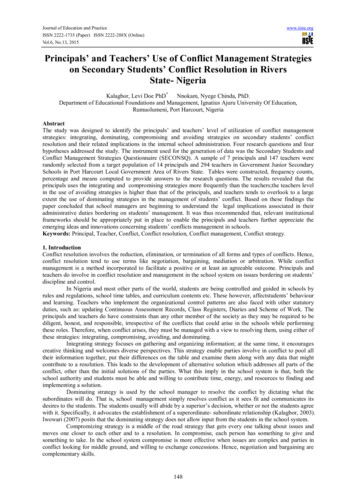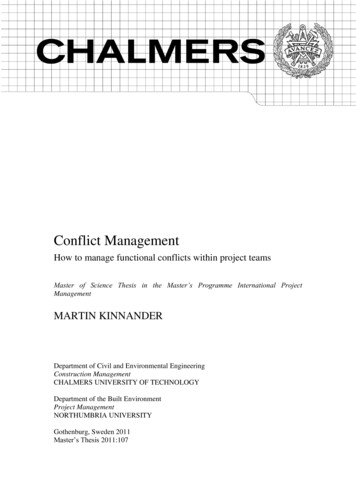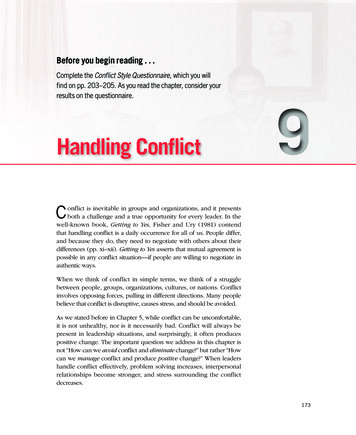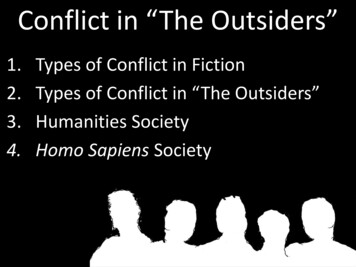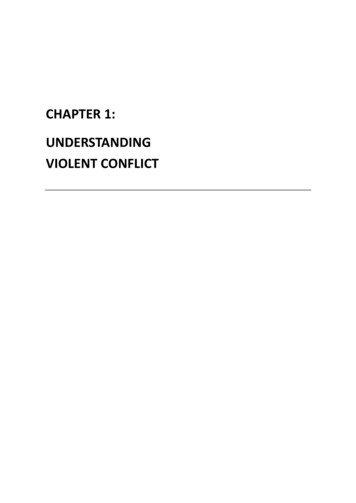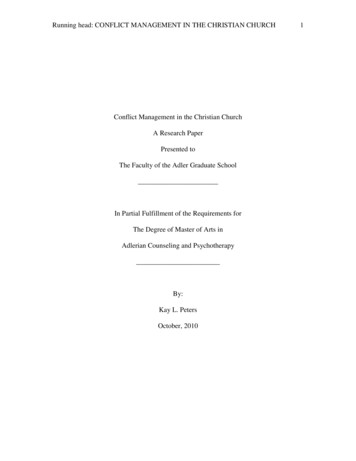
Transcription
Running head: CONFLICT MANAGEMENT IN THE CHRISTIAN CHURCHConflict Management in the Christian ChurchA Research PaperPresented toThe Faculty of the Adler Graduate SchoolIn Partial Fulfillment of the Requirements forThe Degree of Master of Arts inAdlerian Counseling and PsychotherapyBy:Kay L. PetersOctober, 20101
CONFLICT MANAGEMENT IN THE CHRISTIAN CHURCH2CHAPTER 1. INTRODUCTIONIntroduction to the ProblemBeing a Christian pastor today is more difficult than anytime in memory. Thiscentury witnessed the collapse of the Christian consensus that held American culturetogether for centuries. The moral relativism that accompanies a secular view of realitydeeply affects the work of the church and its leadership (Fisher, 1996). Far too manygood pastors are being driven out of ministry, leaving thousands of churches weak andvulnerable to spiritual attack. Without good leadership denominational factions multiply,evangelism declines, divorces proceed unrestrained, discipleship loses direction andmissionaries are forgotten (Sande, 2004).Congregational conflict, defined as a difference in opinion or purpose thatfrustrates someone‟s goals or desires, may occur when those religious and spiritualbeliefs are unaligned (Sande, 2004). This misalignment may take on a psychologicaldimension, since members look to the church for comfort and reassurance in a rapidlychanging and threatening world (Hadden, 1970). Instead of a place of comfort andreassurance, church conflict can create a battle ground for power struggles of variousfactions, victimizing the congregation and sabotaging pastoral leadership and churchgrowth. A pastor is most often forced out of ministry due to lack of success at resolvingdifferences with other people within the church (Sande, 2004).Conflict is not necessarily bad. The Bible, the collection of sacred writings of theChristian religion, teaches that some differences are natural and beneficial. Christiansbelieve that God created people as unique individuals, with different opinions,convictions, desires, perspectives, and priorities. When handled properly, disagreements
CONFLICT MANAGEMENT IN THE CHRISTIAN CHURCH3in these areas can stimulate productive dialogue, encourage creativity, and promotehelpful change and growth.The researcher of this study believed that conflict should not be avoided or feared.Can conflict, managed in a way that is not fear-based, result in positive growth for thechurch? This research delved into understanding the factors associated with churchconflict and leadership conflict management strategies available to pastors.Background of the StudyA Christianity Today International exploratory study (Barfoot, Wickman, &Winston, 1997) revealed that the most common causes for forced pastoral exits include: The church being in a current state of conflict when the pastor arrives; A lack of unity and the presence of factions in the church; Poor people-skills on the part of the pastor; Conflicting visions for the church; A church‟s resistance to change; Power and control struggles; Personality conflicts; Poor people skills on the part of the pastor; Conflict over leadership styles; Dissatisfaction with the pastor‟s performance; and Theological differences (Barfoot et al., p.6).
CONFLICT MANAGEMENT IN THE CHRISTIAN CHURCH4A pastor is most often forced out of ministry due to lack of success at resolvingdifferences with other people within the church (Sande, 2004). The Christianity TodayInternational study further revealed: Forty-five percent of pastors who were forced out of the church think they couldhave done more to avoid being forced out; Resolving conflict was the primary action pastors wished they had taken sooner;and Pastors reported conflict management as the area of training most lacking in theirseminary or Bible college education (Barfoot et al., 1997, p. 11).Conflict can be the result of a violation of shared expectations, or conflict canresult from the clash of two fundamentally different sets of expectations for behavior(Becker, 1999). Previous research shows that intra-congregational conflicts arise overissues of congregational culture, leadership, and denomination (Becker, 1999; Chou,2008); theology, purpose, and meaning (Hadden, 1970); liberalism versus conservatism(Becker, 1999; Haden, 1970); and beliefs and authority (Hoge, 1976). When any of onethese factors are compromised by leadership, it plays a significant role as to why peoplefeel their religious understandings are misaligned and conflict occursEach year thousands of pastors leave their churches, leading to an astronomicalcost of 684 million a year (Sande, 2004). Most congregations have not been properlyequipped to deal with conflict, so when a pastor who is equally unprepared in conflictmanagement enters into such a church, the stage is set for agonizing conflict and disunity(Sande, 2004). The church cannot afford to let these losses continue. This study sought to
CONFLICT MANAGEMENT IN THE CHRISTIAN CHURCH5find a relationship between church leadership conflict management style and positiveenergy growth for unity within the church.Statement of the ProblemThis research study conducted multiple assessments to determine if church leadersunderstood the significance of their conflict management style on the congregation andits members. Is it possible to seek unity without demanding uniformity and transformconflicting situations into positive growth opportunities for the church?Purpose of the StudyThe purpose of this study is to determine how strategies of conflict managementby leadership within the church may impact the overall health of the church. Correlationsamong independent variables of conflict management, education and knowledge, the fearassociated with conflict, and the potential for positive growth outcomes were analyzed.Research QuestionCan church pastoral leaders use conflict management, not in a fear-based way, butin a positive growth-producing way for their churches?Nature of the StudyThe nature of this study consisted of interviewing twenty Christian church leadersfrom various denominations. This research approach presented three measurableassessments. Seven open ended questions were given with the intent to compare conflictmanagement to the growth of their church. The Basis-A Inventory was used to provideinsight into how the church leader approached life‟s task. The Thomas-Kilmann ConflictMode Instrument assessed each leader‟s behavior style in conflict situations. These
CONFLICT MANAGEMENT IN THE CHRISTIAN CHURCH6assessments were measured and compared to identify existing relationships. Thedemographics of each church leader are described in Chapter 3.Definition of TermsThe following terms listed on Table 1 are related to conflict management and tothe Christian church and are referred to throughout this paper.Table 1. Definitions of TermsTermBibleDefinitionA book of the sacred scriptures for Christians comprised of the Old and NewTestaments (Alexander, 1999, p. 18).Christ: Jesus ofNazarethHeld by Christians to be the fulfillment of prophecies in the Old Testament regardingthe eventual coming of a Messiah (Alexander, 1999, p. 28).ChristiansPertaining to, believing in, or believing in the religion based on the teachings ofJesus Christ (Alexander, 1999. p. 246).CongregationalconflictA difference in opinion or purpose that may frustrate an individual‟s goals or desireswhen religious and spiritual beliefs are unaligned (Sande, 2004, p. 12).Jesus: Jesus ofNazarethThe source of the Christian religion was born in Bethlehem shortly before the deathof Herod the Great in 4 BC and spent this early life in Nazareth (Alexander, 1999. p.542).A wrong-doing disobedience, rebellion against God (Alexander, 1999. p 809).SinAssumptions, Limitations and BiasAssumptions. All pastoral leaders interviewed were assumed to have dealt withconflict at some level within their church; to take biblical scripture literally and from anobjective viewpoint; to come from a variety of liberal and conservative theologies; and tobe involved with the conflict management process within their churches. Additionally,conflict was assumed to be fear-based and each church was assumed to have some typeof conflict management model in place.Limitations. This study included limitations. First, only twenty pastoral churchleaders were interviewed. The interviews were limited to Christian protestant
CONFLICT MANAGEMENT IN THE CHRISTIAN CHURCHdenominations whose apostolic flow is directly from the Bible. A final limitation is thatthe interviews came from churches with no less than 300 members and no more than3,000 members.Bias. The researcher of this study has a negative personal experience with thefear-based strategy of conflict management within the church; the use of this strategyresulted in both congregational members and church leaders exiting the church.Organization of the remainder of the studyThis research dissertation is organized into five chapters. Chapter 2 provides areview of the literature on the influential factors related to conflict within the church.This literature review identifies the individual factors, the organizational factors andconflict management factors. Each of these components are analyzed and consideredwhen determining conflict as a positive growth-producing process within the church.Chapter 3 reviews the methodology for this research study.Chapter 4 presents the analysis of the data. The results of the assessments arereviewed in detail.Chapter 5 concludes this research paper. The summary of the results is presented,followed by the conclusion. Recommendations for further study are given.7
CONFLICT MANAGEMENT IN THE CHRISTIAN CHURCH8CHAPTER 2. LITERATURE REVIEWThere is an assumption within the church that behaviors associated with conflict(e.g., anger, hostility, selfishness, differences of opinion) are signs of failure (Leas &Kittlhaus, 1971). “The assumption of failure manifests itself in hiding, suppressing,avoiding or denying dissatisfaction; possibly disclosing the fact that the church is not the„superchurch‟ it is trying to be” (Leas & Kittlhaus, 1971, p. 48). This suggests thatpeople may keep their emotions bottled up, and, when the feelings finally emerge, maybe distorted or expressed inappropriately.Conflict can be differentiated and experienced in three major ways:1. Intrapersonal conflict is a struggle a person has within oneself. It becomes aninternal battle between what they want and yet not wanting to compromisewhat others want.2. Interpersonal conflict is related to differences between people, but is notrelated primarily to uses; striking against the other over their incompatibilityas a person.3. Substantive conflict can be between two individuals or a group, conflictingover facts, means, ends and values (Leas & Kittlehaus, 1971).Feelings do not constitute interpersonal or substantive conflict until they aremanifested in some kind of behavior that strikes against another person or group. Untilhostile feelings are acted upon, the conflict issue is one of an intrapersonal nature.The intrapersonal natured person will call upon the peacemaking responsesbecause they can be carried out personally and privately. These responses are directed
CONFLICT MANAGEMENT IN THE CHRISTIAN CHURCH9toward finding just and mutually agreeable solutions to conflict (Sande, 2004). Theintrapersonal person may respond to conflict in one of the three ways:1. Overlooking an offense. This is a form of forgiveness and involves adeliberate decision not to talk about it, dwell on it, or let it grow into pent-upbitterness or anger. To overlook an offense means that disputes are soinsignificant that they should be resolved quietly and deliberately.2. Reconciliation. This is used when an offense is too serious to overlook or hasdamaged the relationship. To reconcile is to resolve personal or relationalissues through confession, loving correction and forgiveness.3. Negotiation. This should be done through a cooperative bargaining process inwhich both persons seek to reach a settlement that satisfies the legitimateneeds of each side (Sande, 2004, pp. 81-82).People of an interpersonal nature tend to use escape responses when they aremore interested in avoiding a conflict than in resolving it. This attitude is common withinthe church because many Christians believe that all conflict is wrong or dangerous(Sande, 2004). Thinking that Christians should always agree, or fear that conflict willdamage relationships, the interpersonal nature may respond in one of three ways:1. Denial. This occurs when a person pretends that the conflict does not exist; or,if it isn‟t possible to deny that the problem exists, an individual may simplyrefuse to do what should be done to resolve the conflict properly, bringingonly temporary relief and usually making matters worse.
CONFLICT MANAGEMENT IN THE CHRISTIAN CHURCH102. Flight. Running away or escape is another way of not facing conflict. Thisoften time means leaving the church. Running away only postpones a propersolution to a problem.3. Suicide. The most drastic of all options, suicide may occur when people loseall hope of resolving conflict; they seek to escape the situation by attemptingto take their own life (Sande, 2004, pp. 83-84).The substantive natured person will use attack responses when the desiredoutcome to win is more important than it is in preserving a relationship. Attack responsesare typically used by people who are strong and self-confident. But may also be used bythose who feel weak, fearful, insecure or vulnerable (Sande, 2004). The substantiveperson may respond in one of three ways:1. Assault. This is a way for people to try and overcome an opponent by usingvarious forms of force or intimidation, such as verbal attacks, physicalviolence, or efforts to damage a person financially or professionally.2. Litigation. This is a way to force people to bend to ones will by taking them tocourt. This process can be severely damaging to relationships, thus veryimportant to make every effort to settle a dispute out of court if possible.3. Murder. Should an individual be desperate enough to win a dispute, anattempt to kill an opponent may be made. While most Christians would notactually kill someone, their belief that harboring anger or contempt in theirheart is seen biblically as murder in God‟s eyes (Sande, 2004, pp. 89-90).There are areas in the life of church organizations where conflict can play a lifeenhancing and helpful role to group maintenance and mission accomplishment:
CONFLICT MANAGEMENT IN THE CHRISTIAN CHURCH111. Conflict can empower a group, giving it energy and life. A church that has ahealthy amount of tension and conflict is one where programs and plans arechallenged, those which have merit, value and meaning to the mission of thechurch can then be implemented.2. Conflict can help establish identity and boundaries, forcing people to choosesides. Once those sides are chosen, questions can be answered and decisionscan be made.3. Conflict can unify groups of people by helping to play down their differencesand consequently become more effective as task teams.4. Conflict in itself can be a release, a means by which we are able to bringwithin the limits of toleration that which would otherwise be unbearable (Leas& Kittlhaus, 1971, pp. 35-41).A comprehensive study on conflict should go beyond a list of possible causes ofconflict. It should analyze individual and organizational process over potential conflictsreflected in the following statement by Becker (1999):When analyzing a congregation‟s whole pattern of conflict, including what issuespeople fight over, how they frame those issues, typical processes by whichconflict plays out and is resolved, how serious or divisive conflicts are and whateffect they have on the congregation in the long run need to be considered. (p.6)The focus of this study is to explore the individual and organizational factors thatcontribute to conflict and select types of conflict management strategies.
CONFLICT MANAGEMENT IN THE CHRISTIAN CHURCH12Theoretical Framework for Individual and Organizational Influential FactorsSociologists study conflict situations in order to understand the nature andstrength of contending parties (Hoge, 1976). There have been numerous studies on avariety of organized American religions and their internal conflicting battles. From thesestudies several theories have emerged about the cause of congregational conflict. Theresearcher of this paper has looked at several theories on organizational conflict factorsand individual conflict factors. The integration of these theories in relationship tocongregational conflict will then be analyzed to answer the following questions, whichwere posed to pastoral leadership:1. Are there conflict management strategies in place within their church?2. How does each pastor‟s depth of knowledge, experience and conflictmanagement style impact the use of conflict management strategies withineach church?3. How has having or not having conflict management strategies in placeimpacted the health of their church?Organizational Conflict FactorsConflict within the church is a result of several organizational and individualfactors. The loyalty of members to their organizations affects whether they will exit whentheir organizations do not meet their expectations (Hirschman, 1970). This next sectionreviews the impact and effect on organizational conflict factors; those factors include:culture, congregational, leadership, and denominational factors.
CONFLICT MANAGEMENT IN THE CHRISTIAN CHURCH13Culture. Every society, organization, group, and family creates a culture ofconflict. A complex set of words, ideas, values, behaviors, attitudes, archetypes,customs, and rules that powerfully influence how its members think about and respond toconflict. Cultures of conflict are shaped in and by our experiences (Cloke and Goldsmith,2005).Congregations develop distinct cultures that comprise local understandings ofidentity and mission and that can be understood analytically as bundles of core tasks andlegitimate ways of doing things (Becker, 1999). “Participating in church life is a verylocal matter to people. It is their church in their community; it is their worship service,their music program, their budget and their cemetery” (Lehman, 1985, p.17). For thisreason it is important, when looking at church member behavior, as it relates to conflict,that these studies look at church cultural conditions.Congregational. Congregational cultural conflict is one theoretical perspectivethat was examined. Becker (1999) took a look at intra-congregational conflicts byclassifying congregation culture into different types: house of worship, family,community and leader models.Each model displays a general pattern of local congregational culture,congregations with primary emphases on worship; religious education and ritualsare regarded as the „house of worship‟; congregations focusing on close-knit andsupportive relationships are classified as the „family model‟; congregationsplacing emphasis on interpreting and applying shared values on social issuesbelong to the „community model‟; and congregations aiming to express values
CONFLICT MANAGEMENT IN THE CHRISTIAN CHURCH14from the official tenets of their denomination or religious tradition are labeled asthe „leader model.‟ (p. 13)Becker (1999) found that the quantity and quality of intra-congregational conflictsare associated with these congregational models. Community congregations have twicethe number of conflicts as family congregations. Family congregations are more likely tofight over church buildings, while community and leader congregations tend to disagreeon contemporary social issues. Becker (1999) argues that local congregational culturesexplain intra-congregational conflicts better than other variables such as polity andtheological orientation (Chou, 2008).Leadership. Research has shown that many congregational conflicts are relatedto religious leadership (Becker, 1999). The stability of congregations is affected by theirclergy leaders. Whether members are willing to follow these leaders depends on theleader‟s legitimacy. Leaders who are perceived as legitimate face fewer challenges intheir ministry; older experienced educated males tend to have more legitimacy thanyounger less educated and experienced females (Collins, 1975). Charlton (1997)indicated, “Women constitute 8% of all Lutheran ministers and 11% of Methodistministers” (p. 698). Women still constitute a minority of the profession and manycongregations have yet to have a woman in a clergy leadership position. According toCharlton (1997) a Lutheran clergy woman shared the following with her:Maybe other women have had better experiences, but on the whole I havewatched a lot of my sisters in ministry get beat to pieces and left hanging becausethe organized Church says yes, yes we‟ll support you but they don‟t and in realitythe people in the congregation don‟t want you. So you‟re caught .many women
CONFLICT MANAGEMENT IN THE CHRISTIAN CHURCH15have left the ministry because they haven‟t felt the support. Men can walk into aroom and they can automatically command respect by the fact they‟re a malepastor; a female pastor cannot do that. (Charlton, p. 698)For the most part, Americans have channeled their religious activity through localcongregations, and congregation leadership has historically fostered a certain amount ofdemocratic, local, and lay control of decision-making. According to Becker,Since postwar, social changes have fostered more „de facto congregationalism‟across the board and with it a redistribution of religious authority away fromleaders and formal doctrines and toward individuals and congregations asinterpretive communities that are eclectic in their faith expressions. (p. 224)Denomination. Enormous doctrinal differences exist among the variousdenominations. Clergy and laity alike find it difficult to accept many of the traditionaldoctrines that no longer seem plausible (Hadden, 1970).Individual-expressive religion has become the dominant mode of religiousattachment. Economic and educational changes are fostering mobility and the questioningof traditional values and institutions (Becker, 1999). The effects of this goingmodernization have been reconfiguring the American religious landscape at all levels(Liebman, Sutton, & Wuthnow, 1988). These effects include the decline ofdenominational loyalty and authority and its effect on local congregational belief andpractices as reflected in the following statement by Leas and Kittlaus (1971):The gap gets wider and wider between those who want the church involved in theissues of the day and those who cherish the traditional forms and formulations.Conflict has now advanced until it is not grounded in ministry but in the defense
CONFLICT MANAGEMENT IN THE CHRISTIAN CHURCH16of positions. Its mood is not one of fidelity to our mission but one of distrust andacrimony; leading to unhealthy polarization and division. ( p. 15)Schisms are a major source of new religious denominations in America, but havereceived little attention in the sociological literature. Theories of possible origins ofschisms tend to point toward both conflicts over doctrine and problems of churchgovernance and organization (Liebman et al., 1988). One theory is theologicallyconservative denominations are more prone to schisms than liberal ones. Conservatismgenerates dogmatism, which decreases tolerance of internal diversity, increasing thechances of factions breaking away. Another theory is that some denominationaltraditions provide stronger precedents for breaking away, creating a need for a more rigidorganization (Liebman et al., 1988).Individual Conflict FactorsThis section reviews the impact that individual factors have on organizationalconflict. Those factors will include: theology, purpose and meaning, beliefs, andauthority.Theology. Hadden‟s (1970), The Gathering Storm in the Churches main theoryfor the eruption of conflict is based on differences between clergy and laity‟s theology:Clergy have developed a new meaning of the nature of the church; but for avariety of reasons, laity has not shared in the development of this new meaning.Today, laity is beginning to realize that something is different, and for many, thisis a source of the gravest concern, for the new image is in sharp conflict with theirown concept of the meaning and purpose of the church. ( p.6)
CONFLICT MANAGEMENT IN THE CHRISTIAN CHURCH17The older individualistic, literalistic orthodoxy has been challenged by new liberaltheological themes and these new themes are having a profound impact. Because ofclergy‟s exposure to seminary education their theological viewpoints are changing fasterthan laity. Young, new clergy with a strong commitment to social change are oftencritical of the social status quo. This new theology versus old theology results in conflictwith the socially conservative laity who desires no change.Conservative congregations, usually characterized by the belief that they holdexclusive religious truth, perceive their environment as threatening, and keep a greaterdistance from the rest of society. They more often have more committed members,stronger social solidarity, and fewer internal conflicts. Liberal congregations, which aremore accepting of other religions, try to integrate with the rest of society, and appear toexperience more intra-congregational conflicts (Hoge, 1976).Researchers have argued that there are many reasons why liberal congregationsare prone to intra-congregational conflict (Becker, 1999; Hoge, 1976). These mayinclude: Liberal congregations may try to reconcile with or even embrace the secularworldview. This makes liberal congregations more vulnerable to criticism fromboth sides and undermines the current structure (Hoge, 1976). Liberal congregations are more likely to face difference of opinion betweenclergy and laity. Affluent congregations tend to prefer ministers from high-qualityseminaries, but these ministers are more committed to social issues, which mighttranscend members‟ interests and make laity feel insecure and threatened(Hadden, 1970).
CONFLICT MANAGEMENT IN THE CHRISTIAN CHURCH 18The boundaries between liberal congregations and society are more permeable.Since changes in the social environment might result in different reactions withincongregations and members of liberal congregations may have opposing opinionsregarding social issues, more conflicts are expected in liberal congregations(Takayana & Cannon, 1979).The rise of the charismatic, Pentecostal Christian faith, with its emphasis onindividual subjective experience, rejects tradition and hierarchy but rely on directspiritual revelation to supplement or replace biblical authority (Jenkins, 2002). Tworeasons why congregations affected by the charismatic movement are more vulnerable tointernal conflicts are:1. The charismatic movement places more emphasis on individual, subjectiveexperience. Since individual experiences and interpretations may vary,congregations are more likely to experience conflict when a consensus cannotbe reached and each experience and interpretation is equally valued.2. Second, the charismatic movement encourages lay participation and placesless value on hierarchical authority. This type of structure is more prone tointra-congregational conflicts than a centralized and hierarchical structure(Takayama & Cannon, 1979; Chou, 2008).Purpose and meaning. To many, the church is a source of comfort and help in atroubled world, an institution to challenge people to put an end to social injustice in thisworld. This commitment to challenge the church‟s role suggests there may be an inherentconflict between the roles of comforter and challenge. According to Hoge (1976),“Conflict within the church is an issue of mission priorities. One mission for social
CONFLICT MANAGEMENT IN THE CHRISTIAN CHURCH19action, the other for evangelism and efforts to maintain personal moral standards”(p.119). Hoge‟s (1976) research concluded that for most persons the issue is not whetheror not there should be social action, and not whether the corporate church or individualsshould be involved, but whether social action supports laity‟s purpose and meaning orthreatens those interests.Belief. For decades Americans have professed a belief in the existence of God ora universal spirit and a large fraction continue to believe in heaven, hell, an afterlife andthe divinity of Jesus (Iannaccone, 1998). According to Hadden (1970),When symbol and myth are introduced as the basis for understanding thefoundation of a faith, consensus is shattered. What is myth to one is literal toanother who is to say which interpretation is correct, or what is acceptable andunacceptable? In short, when a group can no longer proclaim „Thus saith theLord,‟ the basis of authority has been challenged. What is central doctrine to someis unimportant to others. The boundaries that divide Christians on matters ofbelief are only partially denominational; within denominations and singlecongregations are many beliefs. (p.24)Independent of the content of belief, religion is an overarching, all-embracingsystem of values which defines the nature of ultimate reality. According to Hadden, “Ifone fully accepts the values and beliefs of a religious system, participation in theactivities of that system is a critical way in which acceptance and support will manifestitself” (Hadden, 1970, p. 25).Authority. The church is a voluntary association where laity has very significantauthority. In many denominations laity has the immediate authority to hire and fire a
CONFLICT MANAGEMENT IN THE CHRISTIAN CHURCH20minister, withhold financial contributions and threaten to withdraw membership from theorganization (Hadden, 1970). “By virtue of the fact that
conflict and leadership conflict management strategies available to pastors. Background of the Study A Christianity Today International exploratory study (Barfoot, Wickman, & Winston, 1997) revealed that

